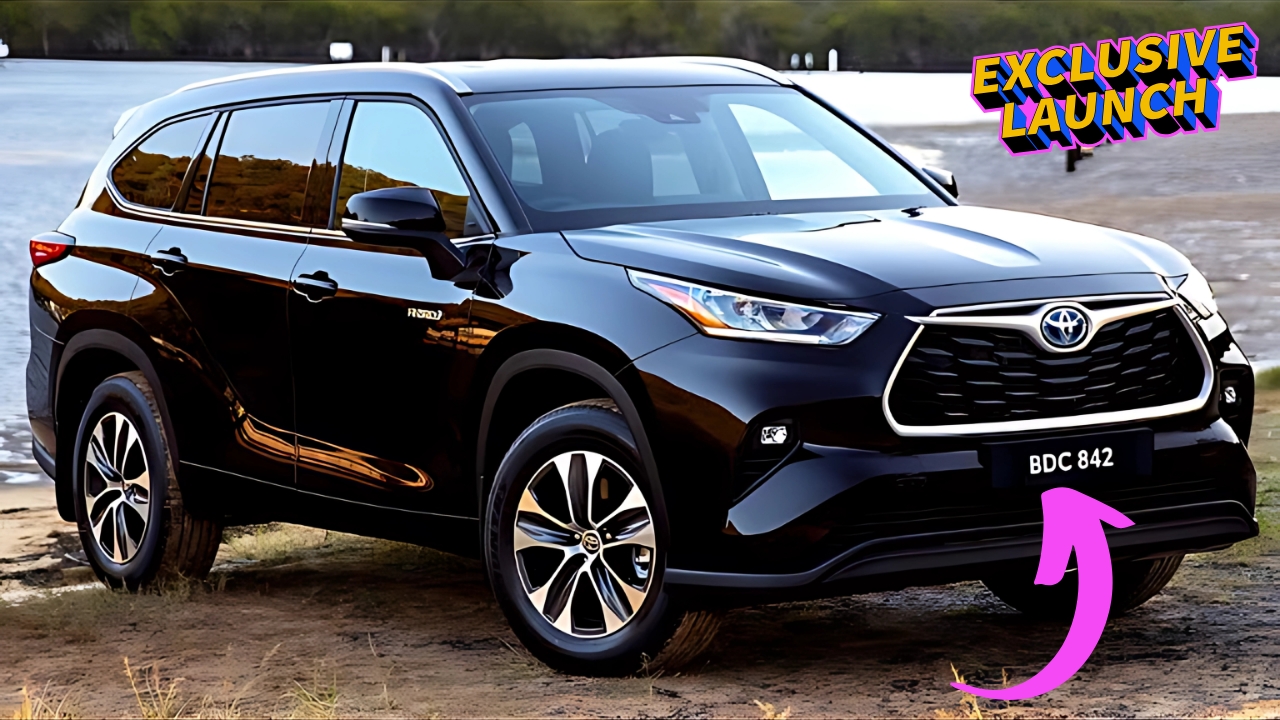Toyota is making headlines with its latest strategic pivot in China, announcing that the next-generation Toyota Kluger (known as Highlander in other markets) will feature an Extended Range Electric Vehicle (EREV) drivetrain option.
The next-generation Toyota Highlander – which is sold in Australia as the Kluger – will be offered with a range-extender EV (EREV) drivetrain option, at least in China.
This groundbreaking development represents Toyota’s most significant adaptation to local market preferences in its decades-long presence in the Chinese automotive sector.
The announcement came during GAC Toyota’s technology day event last week, Toyota said it would tailor core, globally-developed products for the Chinese market in concert with its local development team, local suppliers, and two joint-venture manufacturing partners, GAC and FAW.
This marks a departure from Toyota’s traditionally conservative approach to electrification, signaling the company’s recognition of China’s rapidly evolving automotive landscape.
What is Range-Extender Technology?
Range-extender electric vehicles represent a sophisticated compromise between pure electric vehicles and traditional hybrids. Toyota hasn’t released detailed specs for the new EREV system yet. Based on typical configurations, it’s expected to pair a small combustion engine with a large battery, where the engine acts solely as a generator. Unlike conventional plug-in hybrids where the engine can directly power the wheels, EREV systems use the internal combustion engine exclusively to generate electricity for the battery when needed.
This technology addresses one of the primary concerns of Chinese consumers: range anxiety. EREVs are a type of light hybrid where an ICE — in the case of most Chinese EREVS a 1.5l petrol engine — does not power the vehicle itself at any point but can be used to replenish the battery. Hence the extended range, in most cases taking a 150-300km battery-only range up to 1100-14000km, admittedly using the notoriously optimistic Chinese CLTC measurements.
The appeal of EREV technology in China has been demonstrated by companies like Li Auto, which has seen its sales rise by more than 180pc year-on-year in 2023, far outstripping more modest increase from peers Nio by focusing exclusively on range-extender vehicles.
Toyota’s Strategic Shift in China
This move represents a fundamental change in Toyota’s approach to the Chinese market. Up until now, Toyota’s localisation efforts in China have been limited to revised front-end styling for some models.
This has largely been done to differentiate versions of the same car sold by FAW and GAC. The new strategy involves much deeper localization, with GAC Toyota will appoint local personnel with the deepest understanding of the Chinese market to lead R&D efforts, including new models and facelifts.
This represents a significant departure from Toyota’s traditional centralized development approach. This will transform Toyota’s previous working approach, accelerating the production of better vehicles in China, Toyota said. The company is essentially moving decision-making power from Japan to China, acknowledging that local expertise is crucial for success in the world’s largest automotive market.
GAC and FAW Joint Ventures
Toyota’s Chinese operations are structured through two major joint ventures: GAC Toyota and FAW Toyota. In China, GAC Toyota offers it with hybrid and plug-in hybrid options, while a near-identical sibling, named the Crown Kluger, is sold through FAW Toyota. Both partnerships will be involved in developing and manufacturing the new EREV variants.
The collaboration extends beyond just manufacturing. The vehicle will feature Huawei’s Harmony cockpit and be equipped with Huawei’s DriveONE motor, according to GAC Toyota. This integration of Chinese technology partners demonstrates Toyota’s commitment to leveraging local innovation and supply chains.
Technical Details and Platform Evolution
The upcoming EREV Kluger will be built on Toyota’s proven TNGA-K platform, which currently underpins the existing Highlander/Kluger models. Both the Highlander and Sienna are based on the TNGA-K platform, which also underpins the recently unveiled eighth-generation Lexus ES, which will be offered with a pair of hybrid and pure-electric options.
The platform’s flexibility has been demonstrated across multiple vehicle types and powertrains. The fourth-gen Highlander and fourth-gen Sienna both currently ride on variations of the Japanese automaker’s TNGA-K platform, which is expected to get a light update to adopt an EREV powertrain setup.
Toyota’s approach differs from many competitors who develop entirely new platforms for electric vehicles. Given Toyota’s latest model plan sees it adding pure-electric propulsion options to existing model lines, rather than developing distinct EV-only models to complement separate petrol/hybrid models, the company appears committed to multi-powertrain flexibility.
Market Impact and Competition
The Chinese automotive market has become increasingly competitive, particularly in the electrification space. Toyota’s move comes as Chinese brands like Li Auto, Leapmotor, and others have demonstrated the commercial viability of EREV technology. China’s Leapmotor launched an EREV version of its C11 BEV in March, following its up with super range extender versions of the C01 and C11 in September. Its sales have been a tear ever since, something Leapmotor management attributes firmly to its new approach of offering EREV options alongside BEV.
The market demand for EREV vehicles in China has grown exponentially. Research shows that 17 EREVs either available or under development in China, spanning multiple price segments from budget-friendly options to luxury SUVs. This represents a fundamental shift in consumer preferences, driven by practical considerations around charging infrastructure and range requirements.
Future Implications
The development has significant implications beyond the Chinese market. In theory, if the existing TNGA-K platform can be tweaked to accommodate an EREV powertrain, USDM Highlander and Sienna models could adopt the same at some stage. This suggests that Toyota’s Chinese EREV development could eventually influence global product strategies.
However, Toyota has been cautious about confirming expansion plans. We reached out to Toyota North America to ask if the new powertrain might be offered in the US, but a spokesperson simply said the company “cannot comment on future U.S. products.”
Global Expansion Possibilities
The potential for global expansion remains an open question. Still, considering the growing demand for hybrids and plug-in hybrids, it wouldn’t be all that surprising if a similar offering was sold over here. The technology could be particularly appealing in markets with developing charging infrastructure or where consumers prioritize range flexibility.
The Sienna minivan will also receive EREV treatment in China, with the Chinese-market Sienna will adopt a range-extender powertrain, likely sharing the same underlying system as the Highlander/Kluger. This suggests Toyota is developing a scalable EREV solution that can be adapted across multiple vehicle platforms.
Technical Specifications Comparison
| Feature | Current Kluger Hybrid | Expected EREV Kluger | Typical Chinese EREV |
|---|---|---|---|
| Primary Power | 2.5L + Electric Motor | Electric Motor + Generator | Electric Motor + Generator |
| Battery Size | Small (NiMH) | Large (Lithium) | 30-40 kWh |
| Electric Range | ~2-3 km | 150-300 km | 150-300 km |
| Total Range | 1000+ km | 1100-1400 km | 1100-1400 km |
| Engine Role | Direct Drive + Generator | Generator Only | Generator Only |
| Charging | No External Charging | Plug-in Capable | Plug-in Capable |
Frequently Asked Questions
Q: When will the EREV Kluger be available in China? A: Toyota hasn’t announced specific timing, but the fifth-generation Highlander/Kluger with EREV option is expected to debut around 2026, following the typical product development timeline.
Q: Will the EREV Kluger come to other markets like Australia or the US? A: Toyota hasn’t confirmed plans for other markets. The initial focus is on China, though the platform flexibility suggests potential for global expansion if market demand warrants it.
Q: How does EREV differ from Toyota’s current hybrid technology? A: Unlike current Toyota hybrids where the engine can directly power the wheels, EREV systems use the engine solely as a generator to charge the battery, providing a more electric-focused driving experience with extended range capability.
Q: What’s driving Toyota’s shift to EREV technology? A: Chinese market preferences and competitive pressure from local brands like Li Auto, which have demonstrated strong sales success with EREV vehicles, are key factors in Toyota’s strategic decision.
The Toyota Kluger’s evolution into an EREV represents more than just a powertrain change—it signals Toyota’s recognition that success in China requires embracing local preferences and technology partnerships. As the world’s largest automotive market continues to drive global innovation, this development could well preview the future direction of Toyota’s electrification strategy worldwide.
ALSO READ: BYD& Australian Dreams Start with Atto 2 and Sealion 8

